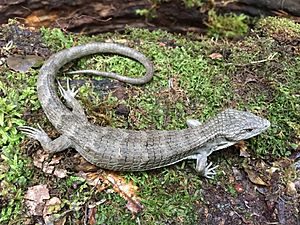Monte Cristo arboreal alligator lizard facts for kids
Quick facts for kids Monte Cristo arboreal alligator lizard |
|
|---|---|
 |
|
| Conservation status | |
| Scientific classification | |
| Genus: |
Abronia (lizard)
|
| Species: |
montecristoi
|
The Monte Cristo arboreal alligator lizard (Abronia montecristoi) is a special type of lizard. It belongs to the family called Anguidae. This lizard is an endangered species, meaning there are very few left in the wild. You can find this lizard living in the cloud forests of El Salvador and Honduras. The IUCN Red List has officially listed it as endangered.
Contents
What's in a Name?
The scientific name for this lizard is montecristoi. This name comes from the place where it was first found. That place was called "Hacienda Montecristo".
How to Spot This Lizard
Scientists don't know a lot about the Monte Cristo arboreal alligator lizard. However, some researchers, like McCranie and Wilson, have described what it looks like. Its back is a color called antique brown. It has pale, cinnamon-colored stripes across its body. The sides of the lizard are a buff-yellow color.
The lizard's head is also cinnamon-colored. The scales on top of its head have tiny black dots. But the sides of its head do not have these dots. Its front legs are cinnamon, and its back legs are a brownish-orange color called tawny. The tail is antique brown with cinnamon stripes. The underside of the lizard is also cinnamon. Its eyes are a pale, greenish-silver color. As its common name suggests, this lizard mostly lives in trees.
Home in the Clouds: Cloud Forests
Very little is known about how the Monte Cristo arboreal alligator lizard lives in its environment. However, we do know it lives in cloud forests. These forests are very important because they have a huge variety of plants and animals.
Cloud forests get their name because they are often covered in clouds. This happens because they are high up, usually between 5,000 and 10,000 feet (about 1,500 to 3,000 meters). Being surrounded by clouds means there is always a lot of water. This constant moisture helps many different kinds of plants and animals to grow there. Even though we don't know exactly how this lizard interacts with its surroundings, it definitely makes its home high up in the trees of these cloud forests.
Protecting This Special Lizard
The future of the Monte Cristo arboreal alligator lizard looks uncertain. This is because the cloud forests where it lives are slowly disappearing. Some scientists believe that these important forests might vanish in the near future.
Cloud forests are home to many different species, not just this lizard. The Monte Cristo arboreal alligator lizard is one of countless animals that rely on these unique habitats. Luckily, there are groups working to protect these forests. The Tropical Montane Cloud Forest Initiative is one such effort. It includes three big conservation programs. These are the United Nations Environment Program, the World Conservation Union, and the World Wide Fund for Nature. They are all working together to save these vital cloud forests and the animals that live in them.
See also
 In Spanish: Dragoncito de Montecristo Metapán for kids
In Spanish: Dragoncito de Montecristo Metapán for kids


